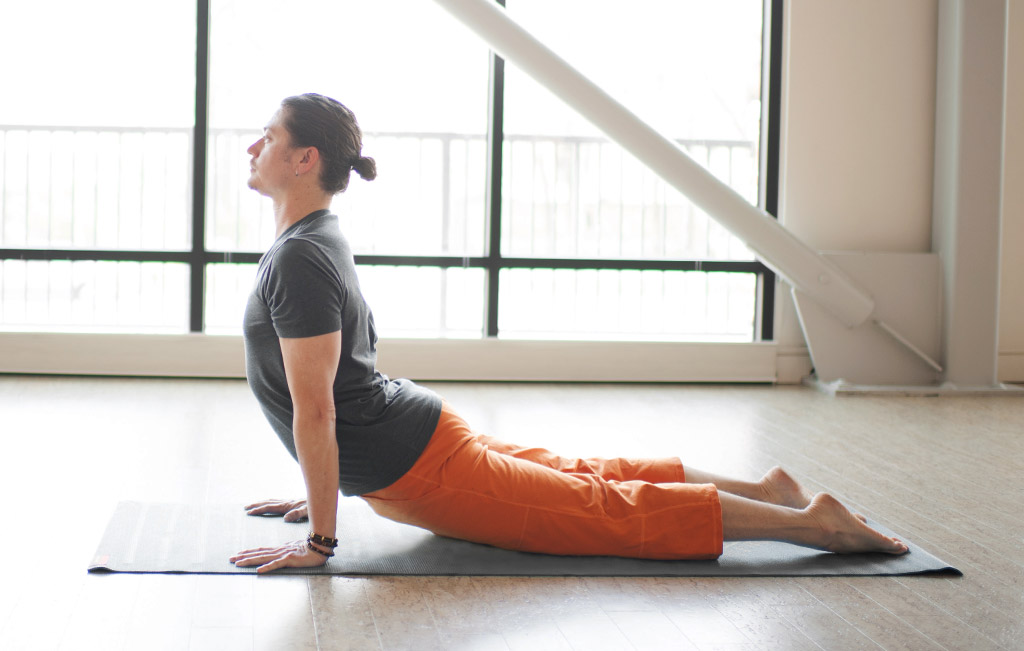
Years ago, Judith Hanson Lasater posed this question in a workshop I was attending: “Who should practice backbends?” After students offered a few answers I don’t recall now she added, “Anyone who’s aging.” This, of course, means everyone.
The most popular backbends come in two varieties: those you practice from a prone position and those you practice from a supine position. Prone backbends include Bhujangasana (Cobra Pose with all its variations), Salabhasana (Locust Pose with all its variations), Dhanurasana (Bow Pose) and Urdva Mukha Svanasana (Upward Facing Dog Pose). Supine backbends include Setu Bandha Sarvangasana (Bridge Pose) and Urdva Dhanurasana (Upward Bow Pose). There are other types, of course, such as Ustrasana (Camel Pose). Even Virabhadrasana I (Warrior I) has backbending elements.
The prone backbends are generally considered to contribute to pelvic and sacroiliac stability and back strength. The focus of this post will be one of the more intense prone backbends, Urdva Mukha Svanasana.
Urdva Mukha Svanasana and Your Low Back
Upward Facing Dog can be challenging for the low back. Unless you actively lift your legs up toward the sky in the pose, their weight can drag on your back, causing tension. Even when you activate the legs to the best of your ability, you may still experience discomfort in Upward Facing Dog Pose.
Judith Hanson Lasater modifies the typically Western adage “No pain no gain,” to align with traditional yogic intention by saying instead: “No pain, no pain,” Yoga is never about pushing yourself to the point of injury. If Upward Facing Dog is not feeling good, there are alternatives. Remember that although every dog has its day, it doesn’t have to be today.
Even though my low back is quite flexible, I always warm up with less challenging backbends such as Sphinx or Cobra. These poses are fine alternatives to Upward Facing Dog, and provide the same benefits—increased energy, clarity of mind, decreased congestion, increased back strength. I also like to practice a few twists and side bends to warm up my middle back before moving into Upward Facing Dog.
How to Practice Urdva Mukha Svanasana
- Lie face down on a nonskid mat. You may want to place a folded blanket under your hipbones for padding. Relax your front body completely into your mat, feeling your abdomen pressing gently into the floor as you inhale. Relax your breath and soften your body around the breath movement.
- Place your hands under your chest, spreading your palms. Make sure your legs are about hips-width apart and that your feet are pointing straight back.
- Now press your knees and tops of your feet into the floor. Then press the floor with your hands to help your chest lift gently off the floor.
- Ground and stretch your legs back behind you. Take a few breaths in Cobra.
- Now support your lumbar by engaging your soft core—your internal organs—in order to give frontal support to your spine. To do this draw your guts—not just your abdominal muscles, but also the contents of your abdomen—back toward your spine.
- If your back is comfortable, turn your toes under and lift your hips and legs off the floor, supporting yourself on your palms and toes. Lift the bones of your legs up toward the sky.
- Press your palms into the ground. Roll the fronts of your shoulders back, let your heart gently lift and look straight ahead. Avoid tilting your head back.
- If your back still feels comfortable, you can move onto the tops of your feet.
- Take five to ten breaths, allowing your body to unwind as you breathe.
- Then move into Adho Mukha Svanasana (Downward Facing Dog Pose). Stay here for a few breaths and gently lower your knees to the floor.
- Rest in Balasana (Child’s Pose).
Urdva Mukha Svanasana expands your heart and invigorates your mind. But take care not to deplete your energy through over-effort. Take it slow. Do only what your body is ready for. Patience will reward you with a healthy, relaxed spine and a simultaneously calm and energized mind.
Updated article from July 7, 2011.
